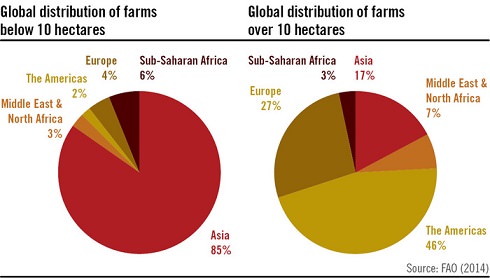Agriculture plays an important part in the world economy. One-third of the economically active population obtains its livelihood from agriculture. In Asia and Africa, millions of small-scale farmers, fishermen, and indigenous people produce most of the food consumed worldwide, in most cases on very small plots of land.
Agriculture is increasingly called upon to address a wide range of critical needs: nutritious food for 9 billion people by 2050, higher and more resilient incomes, and environmental services. If we want to feed a rapidly growing world population, global productivity needs to increase.
There are more than 570 million farms in the world. More than 90% of the farms are managed by an individual or a family and rely primarily on family labor. Family farms occupy a large share of the world’s agricultural land and produce about 80% of the world’s food.
Global distribution of farms (in millions) over and below 10 hectares
Smallholders can be highly productive. They only need to follow farm practices to enhance their productivity and to produce more on the same field area.
This is where AGRIVI software helps; it provides knowledge about the best farming practices in order to direct food production towards durable farming, that is observant of the environment, and results in the production of good quality food.
The main objective is to bring awareness to farmers about the importance of implementing knowledge and best practices to improve the production system to yield more food. With Agrivi software, farmers can find best farm practices in the form of tasks which guide them chronologically what to do during a growing season. The software provides tasks for the 100 most common crops, such as apples, bananas, corn, manioca, tomatoes, potatoes, wheat and others. Tasks are principles and technical recommendations of all processes of crop production such as:
- Soil management; to have fertile soil and a good crop yield, it is necessary to use adequate soil conservation techniques such as timely and proper tillage, crop rotation and regular monitoring of soil pH
- Water management; sufficient water amount during the growth stages in which water is the most crucial to achieve planned yield
- Cropping system management; agroforestry system integrates, on the same farmland, crops and trees together for farming, producing fruit and raising livestock
- Fertilization; regular addition of manure and other biological fertilizers to enhance soil matter; adding of plant nutrients (N, P, K and micronutrients) according to crop needs and phenophases
- Planting/sowing; sowing of certified seeds, resistant varieties and proper planting time and care
- Crop maintenance; regular maintenance of plant and row space in orchard or weed cultivation in the fields of vegetables and arable crops
- Protection management; on-time insect pest, disease and weed protection with biological, mechanical or chemical products
- Harvesting; harvesting of fruits in physiological and technological maturity with proper fruit handling; care should be taken on waiting period after pesticide treatment
- Storage; fruits must be stored in adequate temperature, humidity, and space conditions.
Whether you farm in a conventional, organic or integrated way, AGRIVI gives you a knowledge base for your crop production. The additional value of farm practices in the form of tasks makes it possible to enter and track usage for every farm activity; work hours of workers and machinery; insect pest, weed or disease protection, irrigation, fertilization, and harvesting. Every usage can be distributed on the geographical locations of fields on which a particular crop is being grown.
The AGRIVI reporting feature will ensure that the produce is linked to real data illustrating how it was treated throughout the growing season by location. This will ensure a competitive edge and easier access to buyers of harvested produce.
Text and image source: Global Agriculture





